Tao Xu
College of Intelligent Systems Science and Engineering, Harbin Engineering University, Harbin, China
Adaptive Wavelet Filters as Practical Texture Feature Amplifiers for Parkinson's Disease Screening in OCT
Mar 25, 2025Abstract:Parkinson's disease (PD) is a prevalent neurodegenerative disorder globally. The eye's retina is an extension of the brain and has great potential in PD screening. Recent studies have suggested that texture features extracted from retinal layers can be adopted as biomarkers for PD diagnosis under optical coherence tomography (OCT) images. Frequency domain learning techniques can enhance the feature representations of deep neural networks (DNNs) by decomposing frequency components involving rich texture features. Additionally, previous works have not exploited texture features for automated PD screening in OCT. Motivated by the above analysis, we propose a novel Adaptive Wavelet Filter (AWF) that serves as the Practical Texture Feature Amplifier to fully leverage the merits of texture features to boost the PD screening performance of DNNs with the aid of frequency domain learning. Specifically, AWF first enhances texture feature representation diversities via channel mixer, then emphasizes informative texture feature representations with the well-designed adaptive wavelet filtering token mixer. By combining the AWFs with the DNN stem, AWFNet is constructed for automated PD screening. Additionally, we introduce a novel Balanced Confidence (BC) Loss by mining the potential of sample-wise predicted probabilities of all classes and class frequency prior, to further boost the PD screening performance and trustworthiness of AWFNet. The extensive experiments manifest the superiority of our AWFNet and BC over state-of-the-art methods in terms of PD screening performance and trustworthiness.
Learnings from Scaling Visual Tokenizers for Reconstruction and Generation
Jan 16, 2025



Abstract:Visual tokenization via auto-encoding empowers state-of-the-art image and video generative models by compressing pixels into a latent space. Although scaling Transformer-based generators has been central to recent advances, the tokenizer component itself is rarely scaled, leaving open questions about how auto-encoder design choices influence both its objective of reconstruction and downstream generative performance. Our work aims to conduct an exploration of scaling in auto-encoders to fill in this blank. To facilitate this exploration, we replace the typical convolutional backbone with an enhanced Vision Transformer architecture for Tokenization (ViTok). We train ViTok on large-scale image and video datasets far exceeding ImageNet-1K, removing data constraints on tokenizer scaling. We first study how scaling the auto-encoder bottleneck affects both reconstruction and generation -- and find that while it is highly correlated with reconstruction, its relationship with generation is more complex. We next explored the effect of separately scaling the auto-encoders' encoder and decoder on reconstruction and generation performance. Crucially, we find that scaling the encoder yields minimal gains for either reconstruction or generation, while scaling the decoder boosts reconstruction but the benefits for generation are mixed. Building on our exploration, we design ViTok as a lightweight auto-encoder that achieves competitive performance with state-of-the-art auto-encoders on ImageNet-1K and COCO reconstruction tasks (256p and 512p) while outperforming existing auto-encoders on 16-frame 128p video reconstruction for UCF-101, all with 2-5x fewer FLOPs. When integrated with Diffusion Transformers, ViTok demonstrates competitive performance on image generation for ImageNet-1K and sets new state-of-the-art benchmarks for class-conditional video generation on UCF-101.
LinGen: Towards High-Resolution Minute-Length Text-to-Video Generation with Linear Computational Complexity
Dec 13, 2024



Abstract:Text-to-video generation enhances content creation but is highly computationally intensive: The computational cost of Diffusion Transformers (DiTs) scales quadratically in the number of pixels. This makes minute-length video generation extremely expensive, limiting most existing models to generating videos of only 10-20 seconds length. We propose a Linear-complexity text-to-video Generation (LinGen) framework whose cost scales linearly in the number of pixels. For the first time, LinGen enables high-resolution minute-length video generation on a single GPU without compromising quality. It replaces the computationally-dominant and quadratic-complexity block, self-attention, with a linear-complexity block called MATE, which consists of an MA-branch and a TE-branch. The MA-branch targets short-to-long-range correlations, combining a bidirectional Mamba2 block with our token rearrangement method, Rotary Major Scan, and our review tokens developed for long video generation. The TE-branch is a novel TEmporal Swin Attention block that focuses on temporal correlations between adjacent tokens and medium-range tokens. The MATE block addresses the adjacency preservation issue of Mamba and improves the consistency of generated videos significantly. Experimental results show that LinGen outperforms DiT (with a 75.6% win rate) in video quality with up to 15$\times$ (11.5$\times$) FLOPs (latency) reduction. Furthermore, both automatic metrics and human evaluation demonstrate our LinGen-4B yields comparable video quality to state-of-the-art models (with a 50.5%, 52.1%, 49.1% win rate with respect to Gen-3, LumaLabs, and Kling, respectively). This paves the way to hour-length movie generation and real-time interactive video generation. We provide 68s video generation results and more examples in our project website: https://lineargen.github.io/.
Reject Threshold Adaptation for Open-Set Model Attribution of Deepfake Audio
Dec 02, 2024

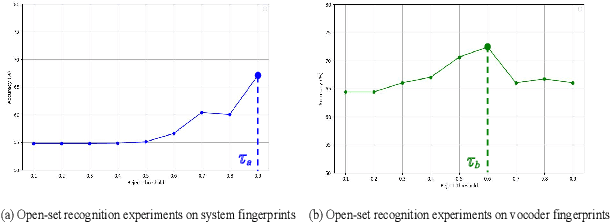

Abstract:Open environment oriented open set model attribution of deepfake audio is an emerging research topic, aiming to identify the generation models of deepfake audio. Most previous work requires manually setting a rejection threshold for unknown classes to compare with predicted probabilities. However, models often overfit training instances and generate overly confident predictions. Moreover, thresholds that effectively distinguish unknown categories in the current dataset may not be suitable for identifying known and unknown categories in another data distribution. To address the issues, we propose a novel framework for open set model attribution of deepfake audio with rejection threshold adaptation (ReTA). Specifically, the reconstruction error learning module trains by combining the representation of system fingerprints with labels corresponding to either the target class or a randomly chosen other class label. This process generates matching and non-matching reconstructed samples, establishing the reconstruction error distributions for each class and laying the foundation for the reject threshold calculation module. The reject threshold calculation module utilizes gaussian probability estimation to fit the distributions of matching and non-matching reconstruction errors. It then computes adaptive reject thresholds for all classes through probability minimization criteria. The experimental results demonstrate the effectiveness of ReTA in improving the open set model attributes of deepfake audio.
Smart Predict-then-Optimize Method with Dependent Data: Risk Bounds and Calibration of Autoregression
Nov 19, 2024Abstract:The predict-then-optimize (PTO) framework is indispensable for addressing practical stochastic decision-making tasks. It consists of two crucial steps: initially predicting unknown parameters of an optimization model and subsequently solving the problem based on these predictions. Elmachtoub and Grigas [1] introduced the Smart Predict-then-Optimize (SPO) loss for the framework, which gauges the decision error arising from predicted parameters, and a convex surrogate, the SPO+ loss, which incorporates the underlying structure of the optimization model. The consistency of these different loss functions is guaranteed under the assumption of i.i.d. training data. Nevertheless, various types of data are often dependent, such as power load fluctuations over time. This dependent nature can lead to diminished model performance in testing or real-world applications. Motivated to make intelligent predictions for time series data, we present an autoregressive SPO method directly targeting the optimization problem at the decision stage in this paper, where the conditions of consistency are no longer met. Therefore, we first analyze the generalization bounds of the SPO loss within our autoregressive model. Subsequently, the uniform calibration results in Liu and Grigas [2] are extended in the proposed model. Finally, we conduct experiments to empirically demonstrate the effectiveness of the SPO+ surrogate compared to the absolute loss and the least squares loss, especially when the cost vectors are determined by stationary dynamical systems and demonstrate the relationship between normalized regret and mixing coefficients.
GPT-4o System Card
Oct 25, 2024Abstract:GPT-4o is an autoregressive omni model that accepts as input any combination of text, audio, image, and video, and generates any combination of text, audio, and image outputs. It's trained end-to-end across text, vision, and audio, meaning all inputs and outputs are processed by the same neural network. GPT-4o can respond to audio inputs in as little as 232 milliseconds, with an average of 320 milliseconds, which is similar to human response time in conversation. It matches GPT-4 Turbo performance on text in English and code, with significant improvement on text in non-English languages, while also being much faster and 50\% cheaper in the API. GPT-4o is especially better at vision and audio understanding compared to existing models. In line with our commitment to building AI safely and consistent with our voluntary commitments to the White House, we are sharing the GPT-4o System Card, which includes our Preparedness Framework evaluations. In this System Card, we provide a detailed look at GPT-4o's capabilities, limitations, and safety evaluations across multiple categories, focusing on speech-to-speech while also evaluating text and image capabilities, and measures we've implemented to ensure the model is safe and aligned. We also include third-party assessments on dangerous capabilities, as well as discussion of potential societal impacts of GPT-4o's text and vision capabilities.
Movie Gen: A Cast of Media Foundation Models
Oct 17, 2024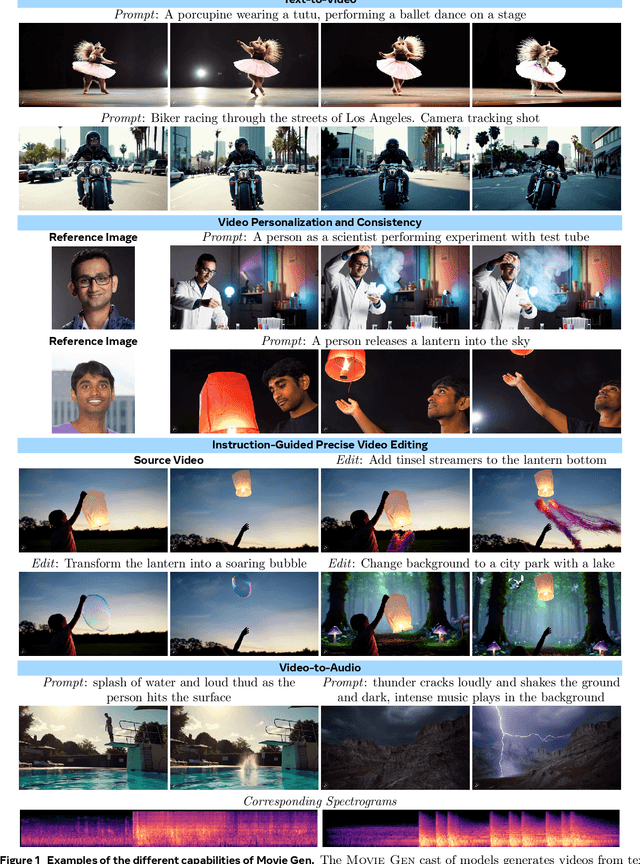

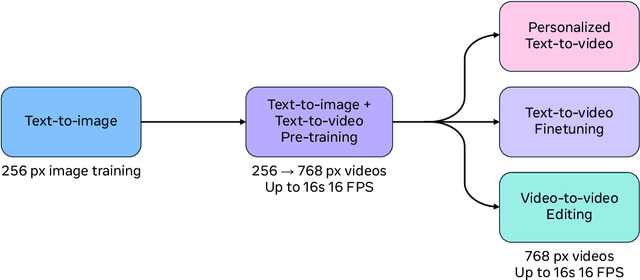
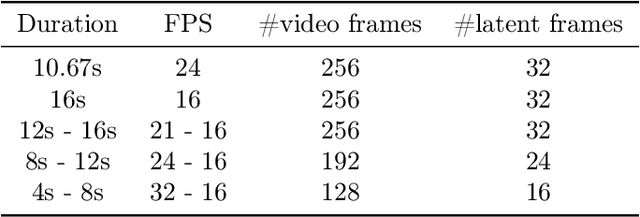
Abstract:We present Movie Gen, a cast of foundation models that generates high-quality, 1080p HD videos with different aspect ratios and synchronized audio. We also show additional capabilities such as precise instruction-based video editing and generation of personalized videos based on a user's image. Our models set a new state-of-the-art on multiple tasks: text-to-video synthesis, video personalization, video editing, video-to-audio generation, and text-to-audio generation. Our largest video generation model is a 30B parameter transformer trained with a maximum context length of 73K video tokens, corresponding to a generated video of 16 seconds at 16 frames-per-second. We show multiple technical innovations and simplifications on the architecture, latent spaces, training objectives and recipes, data curation, evaluation protocols, parallelization techniques, and inference optimizations that allow us to reap the benefits of scaling pre-training data, model size, and training compute for training large scale media generation models. We hope this paper helps the research community to accelerate progress and innovation in media generation models. All videos from this paper are available at https://go.fb.me/MovieGenResearchVideos.
Img2CAD: Conditioned 3D CAD Model Generation from Single Image with Structured Visual Geometry
Oct 04, 2024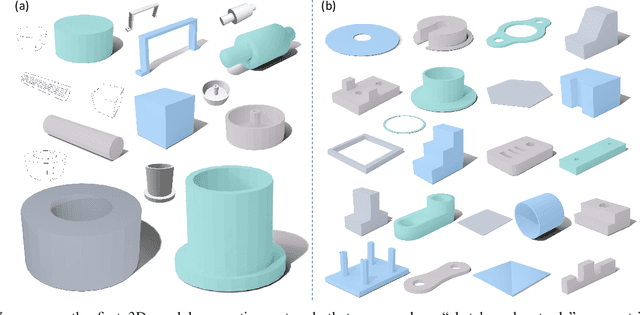
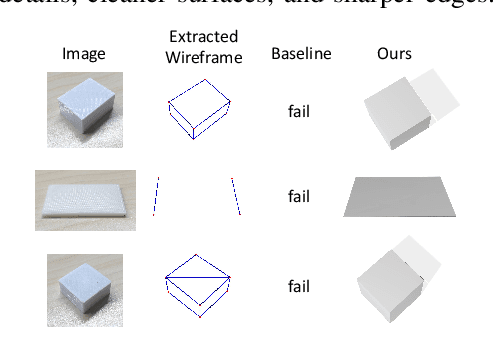
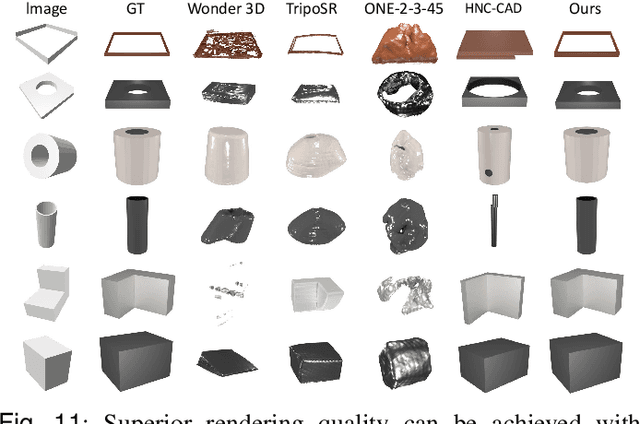

Abstract:In this paper, we propose Img2CAD, the first approach to our knowledge that uses 2D image inputs to generate CAD models with editable parameters. Unlike existing AI methods for 3D model generation using text or image inputs often rely on mesh-based representations, which are incompatible with CAD tools and lack editability and fine control, Img2CAD enables seamless integration between AI-based 3D reconstruction and CAD software. We have identified an innovative intermediate representation called Structured Visual Geometry (SVG), characterized by vectorized wireframes extracted from objects. This representation significantly enhances the performance of generating conditioned CAD models. Additionally, we introduce two new datasets to further support research in this area: ABC-mono, the largest known dataset comprising over 200,000 3D CAD models with rendered images, and KOCAD, the first dataset featuring real-world captured objects alongside their ground truth CAD models, supporting further research in conditioned CAD model generation.
DRExplainer: Quantifiable Interpretability in Drug Response Prediction with Directed Graph Convolutional Network
Aug 22, 2024Abstract:Predicting the response of a cancer cell line to a therapeutic drug is pivotal for personalized medicine. Despite numerous deep learning methods that have been developed for drug response prediction, integrating diverse information about biological entities and predicting the directional response remain major challenges. Here, we propose a novel interpretable predictive model, DRExplainer, which leverages a directed graph convolutional network to enhance the prediction in a directed bipartite network framework. DRExplainer constructs a directed bipartite network integrating multi-omics profiles of cell lines, the chemical structure of drugs and known drug response to achieve directed prediction. Then, DRExplainer identifies the most relevant subgraph to each prediction in this directed bipartite network by learning a mask, facilitating critical medical decision-making. Additionally, we introduce a quantifiable method for model interpretability that leverages a ground truth benchmark dataset curated from biological features. In computational experiments, DRExplainer outperforms state-of-the-art predictive methods and another graph-based explanation method under the same experimental setting. Finally, the case studies further validate the interpretability and the effectiveness of DRExplainer in predictive novel drug response. Our code is available at: https://github.com/vshy-dream/DRExplainer.
xLSTM-UNet can be an Effective 2D & 3D Medical Image Segmentation Backbone with Vision-LSTM (ViL) better than its Mamba Counterpart
Jul 02, 2024Abstract:Convolutional Neural Networks (CNNs) and Vision Transformers (ViT) have been pivotal in biomedical image segmentation, yet their ability to manage long-range dependencies remains constrained by inherent locality and computational overhead. To overcome these challenges, in this technical report, we first propose xLSTM-UNet, a UNet structured deep learning neural network that leverages Vision-LSTM (xLSTM) as its backbone for medical image segmentation. xLSTM is a recently proposed as the successor of Long Short-Term Memory (LSTM) networks and have demonstrated superior performance compared to Transformers and State Space Models (SSMs) like Mamba in Neural Language Processing (NLP) and image classification (as demonstrated in Vision-LSTM, or ViL implementation). Here, xLSTM-UNet we designed extend the success in biomedical image segmentation domain. By integrating the local feature extraction strengths of convolutional layers with the long-range dependency capturing abilities of xLSTM, xLSTM-UNet offers a robust solution for comprehensive image analysis. We validate the efficacy of xLSTM-UNet through experiments. Our findings demonstrate that xLSTM-UNet consistently surpasses the performance of leading CNN-based, Transformer-based, and Mamba-based segmentation networks in multiple datasets in biomedical segmentation including organs in abdomen MRI, instruments in endoscopic images, and cells in microscopic images. With comprehensive experiments performed, this technical report highlights the potential of xLSTM-based architectures in advancing biomedical image analysis in both 2D and 3D. The code, models, and datasets are publicly available at http://tianrun-chen.github.io/xLSTM-UNet/
 Add to Chrome
Add to Chrome Add to Firefox
Add to Firefox Add to Edge
Add to Edge